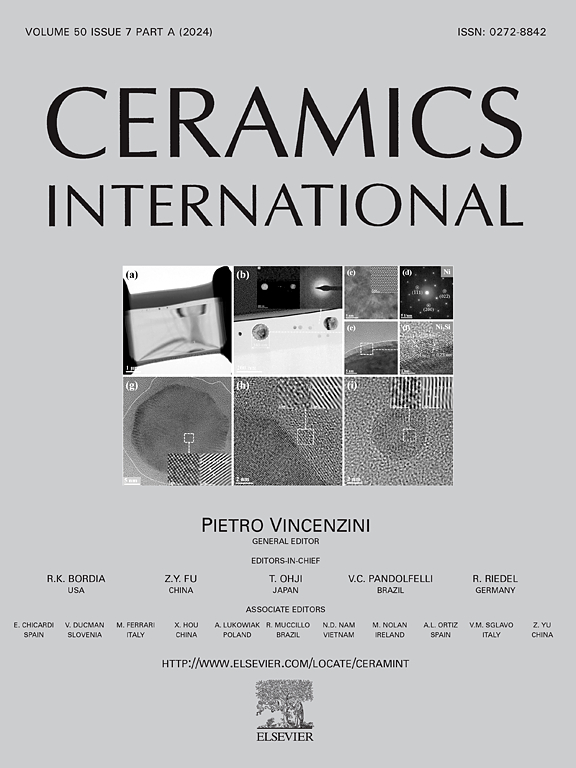Sintering, high-temperature stability, and thermal conductivity of (Zr, Nb, Hf, Ta)(C, N) high-entropy carbonitrides
IF 5.1
2区 材料科学
Q1 MATERIALS SCIENCE, CERAMICS
引用次数: 0
Abstract
High-entropy carbonitrides (HECNs), a new class of high-performance ceramics, hold great potential for high-temperature structural materials and thermal protection systems due to their excellent thermal stability and properties. For its better application, it is important to optimize the sintering temperature of HECNs and deeply investigate its thermal conductivity behavior. This study systematically investigates the thermodynamic stability, formation ability, and thermal properties of (ZrHfNbTa)CxN1-x through first-principles calculations and experimental validation. Thermodynamic calculations reveal that nitrogen incorporation reduces the sintering temperature required to achieve a stable high-entropy solid solution. Experimental validation by spark plasma sintering (SPS) shows that the sintering temperature can be reduced from 1950 °C to 1700 °C. Ab initio molecular dynamics (AIMD) simulations demonstrate that HECNs retain structural integrity at 1773 K. Thermal conductivity tests show an increase with temperature, but a decrease with higher nitrogen content, which is mainly caused by the increased scattering of phonons resulting from lattice distortions. The Debye-Callaway model fitting further elucidates the underlying thermal conductivity mechanisms. In summary, nitrogen incorporation enhances the thermodynamic stability and reduces thermal conductivity of HECN ceramics, providing valuable theoretical and experimental support for their application in high-temperature structural materials and thermal protection systems.
(Zr, Nb, Hf, Ta)(C, N)高熵碳氮化物的烧结、高温稳定性和导热性
高熵碳氮化物(HECNs)是一类新型的高性能陶瓷,由于其优异的热稳定性和性能,在高温结构材料和热防护系统中具有巨大的潜力。为了更好的应用,优化hecn的烧结温度和深入研究其导热性能是非常重要的。本研究通过第一性原理计算和实验验证,系统研究了(ZrHfNbTa)CxN1-x的热力学稳定性、形成能力和热性能。热力学计算表明,氮的加入降低了达到稳定的高熵固溶体所需的烧结温度。火花等离子烧结(SPS)实验验证表明,烧结温度可从1950℃降低到1700℃。从头算分子动力学(AIMD)模拟表明,hecn在1773 K时保持结构完整性。热导率随温度升高而升高,但随氮含量的增加而降低,这主要是由于晶格畸变导致声子散射增加所致。Debye-Callaway模型拟合进一步阐明了潜在的导热机制。综上所述,氮的掺入提高了HECN陶瓷的热力学稳定性,降低了其导热系数,为其在高温结构材料和热防护系统中的应用提供了有价值的理论和实验支持。
本文章由计算机程序翻译,如有差异,请以英文原文为准。
求助全文
约1分钟内获得全文
求助全文
来源期刊

Ceramics International
工程技术-材料科学:硅酸盐
CiteScore
9.40
自引率
15.40%
发文量
4558
审稿时长
25 days
期刊介绍:
Ceramics International covers the science of advanced ceramic materials. The journal encourages contributions that demonstrate how an understanding of the basic chemical and physical phenomena may direct materials design and stimulate ideas for new or improved processing techniques, in order to obtain materials with desired structural features and properties.
Ceramics International covers oxide and non-oxide ceramics, functional glasses, glass ceramics, amorphous inorganic non-metallic materials (and their combinations with metal and organic materials), in the form of particulates, dense or porous bodies, thin/thick films and laminated, graded and composite structures. Process related topics such as ceramic-ceramic joints or joining ceramics with dissimilar materials, as well as surface finishing and conditioning are also covered. Besides traditional processing techniques, manufacturing routes of interest include innovative procedures benefiting from externally applied stresses, electromagnetic fields and energetic beams, as well as top-down and self-assembly nanotechnology approaches. In addition, the journal welcomes submissions on bio-inspired and bio-enabled materials designs, experimentally validated multi scale modelling and simulation for materials design, and the use of the most advanced chemical and physical characterization techniques of structure, properties and behaviour.
Technologically relevant low-dimensional systems are a particular focus of Ceramics International. These include 0, 1 and 2-D nanomaterials (also covering CNTs, graphene and related materials, and diamond-like carbons), their nanocomposites, as well as nano-hybrids and hierarchical multifunctional nanostructures that might integrate molecular, biological and electronic components.
 求助内容:
求助内容: 应助结果提醒方式:
应助结果提醒方式:


